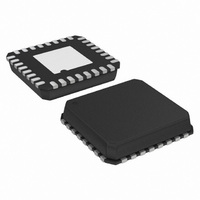ADUC7061BCPZ32-RL Analog Devices Inc, ADUC7061BCPZ32-RL Datasheet - Page 21

ADUC7061BCPZ32-RL
Manufacturer Part Number
ADUC7061BCPZ32-RL
Description
DUAL 24-BIT AFE AND ARM 7 I.C
Manufacturer
Analog Devices Inc
Series
MicroConverter® ADuC7xxxr
Datasheet
1.EVAL-ADUC7061MKZ.pdf
(108 pages)
Specifications of ADUC7061BCPZ32-RL
Design Resources
USB Based Temperature Monitor Using ADuC7061 and an External RTD (CN0075) 4 mA-to-20 mA Loop-Powered Temperature Monitor Using ADuC7060/1 (CN0145)
Core Processor
ARM7
Core Size
16/32-Bit
Speed
10MHz
Connectivity
I²C, SPI, UART/USART
Peripherals
POR, PWM, Temp Sensor, WDT
Number Of I /o
8
Program Memory Size
32KB (32K x 8)
Program Memory Type
FLASH
Ram Size
4K x 8
Voltage - Supply (vcc/vdd)
2.375 V ~ 2.625 V
Data Converters
A/D 5x24b, 8x24b, D/A 1x14b
Oscillator Type
Internal
Operating Temperature
-40°C ~ 125°C
Package / Case
32-LFCSP
Lead Free Status / RoHS Status
Lead free / RoHS Compliant
Eeprom Size
-
Lead Free Status / RoHS Status
Lead free / RoHS Compliant
OVERVIEW OF THE ARM7TDMI CORE
The ARM7® core is a 32-bit, reduced instruction set computer
(RISC), developed by ARM® Ltd. The ARM7TDMI is a
von Neumann-based architecture, meaning that it uses a single
32-bit bus for instruction and data. The length of the data can
be 8, 16, or 32 bits, and the length of the instruction word is
either 16 bits or 32 bits, depending on the mode in which the
core is operating.
The ARM7TDMI is an ARM7 core with four additional
features, as listed in Table 10.
Table 10. ARM7TDMI Features
Feature
T
D
M
I
THUMB MODE (T)
An ARM instruction is 32 bits long. The ARM7TDMI processor
supports a second instruction set compressed into 16 bits, the
Thumb instruction set. Faster code execution from 16-bit memory
and greater code density is achieved by using the Thumb instruc-
tion set, making the ARM7TDMI core particularly suited for
embedded applications.
However, the Thumb mode has three limitations.
•
•
•
MULTIPLIER (M)
The ARM7TDMI instruction set includes an enhanced
multiplier, with four extra instructions to perform 32-bit by
32-bit multiplication with a 64-bit result, and 32-bit by 32-bit
multiplication-accumulation (MAC) with a 64-bit result.
EmbeddedICE (I)
The EmbeddedICE module provides integrated on-chip debug
support for the ARM7TDMI. The EmbeddedICE module
contains the breakpoint and watchpoint registers that allow
nonintrusive user code debugging. These registers are con-
trolled through the JTAG test port. When a breakpoint or
watchpoint is encountered, the processor halts and enters the
debug state. When in a debug state, the processor registers can
be interrogated, as can the Flash/EE, SRAM, and memory
mapped registers.
Relative to ARM, the Thumb code usually requires more
instructions to perform the same task. Therefore, ARM
code is best for maximizing the performance of time-
critical code in most applications.
The Thumb instruction set does not include some
instructions that are needed for exception handling, so
ARM code can be required for exception handling.
When an interrupt occurs, the core vectors to the interrupt
location in memory and executes the code present at that
address. The first command is required to be in ARM code.
Support for the Thumb® (16-bit) instruction set
Support for debug
Enhanced multiplier
Includes the EmbeddedICE® module to support
embedded system debugging
Description
Rev. B | Page 21 of 108
ARM7 Exceptions
The ARM7 supports five types of exceptions, with a privileged
processing mode associated with each type. The five types of
exceptions are as follows:
Type 1: normal interrupt or IRQ. This is provided to service
general-purpose interrupt handling of internal and external
events. Note that the ADuC706x supports eight configurable
priority levels for all IRQ sources.
Type 2: fast interrupt or FIQ. This is provided to service data
transfer or a communication channel with low latency. FIQ has
priority over IRQ. Note that the ADuC706x supports eight
configurable priority levels for all FIQ sources.
Type 3: memory abort (prefetch and data).
Type 4: attempted execution of an undefined instruction.
Type 5: software interrupts (SWI) instruction that can be used
to make a call to an operating system.
Typically, the programmer defines interrupts as IRQ, but for
higher priority interrupts, the programmer can define
interrupts as the FIQ type.
The priority of these exceptions and vector addresses are listed
in Table 11.
Table 11. Exception Priorities and Vector Addresses
Priority
1
2
3
4
5
6
6
1
The exceptions listed in Table 11 are located from 0x00 to 0x1C,
with a reserved location at 0x14.
ARM REGISTERS
The ARM7TDMI has 16 standard registers. R0 to R12 are for
data manipulation, R13 is the stack pointer, R14 is the link
register, and R15 is the program counter that indicates the
instruction currently being executed. The link register contains
the address from which the user has branched (when using the
branch and link command) or the command during which an
exception occurred.
The stack pointer contains the current location of the stack.
Generally, on an ARM7TDMI, the stack starts at the top of the
available RAM area and descends using the area as required. A
separate stack is defined for each of the exceptions. The size of
each stack is user configurable and is dependent on the target
application. When programming using high level languages,
priority and are mutually exclusive.
A software interrupt and an undefined instruction exception have the same
Exception
Hardware reset
Memory abort (data)
FIQ
IRQ
Memory abort (prefetch)
Software interrupt
Undefined instruction
ADuC7060/ADuC7061
1
1
Address
0x00
0x10
0x1C
0x18
0x0C
0x08
0x04












